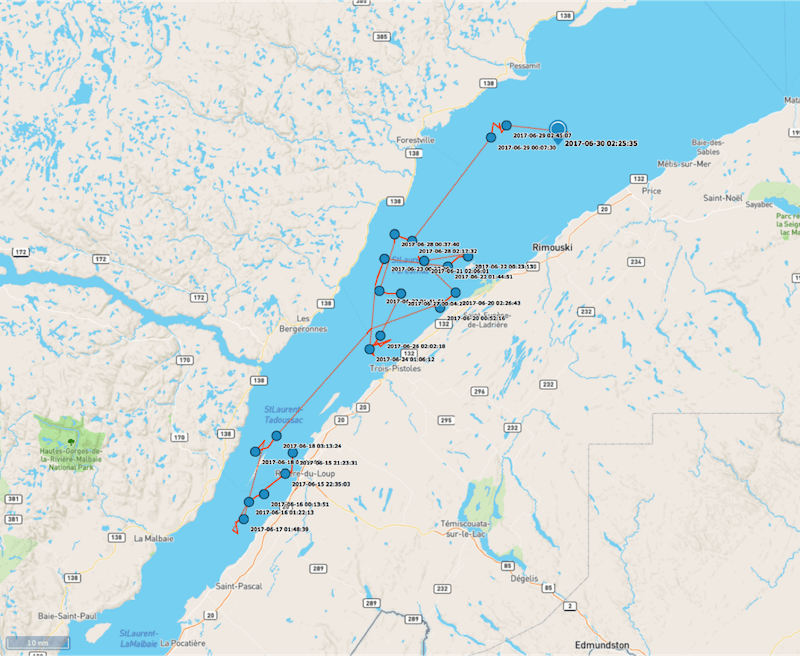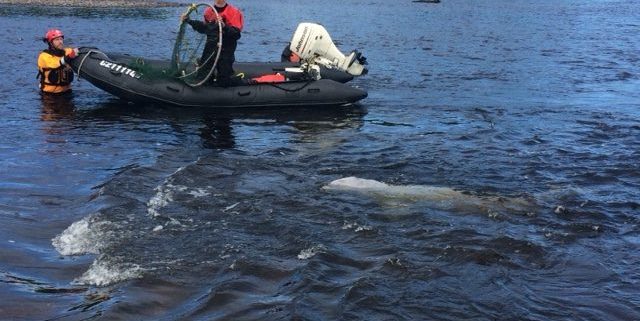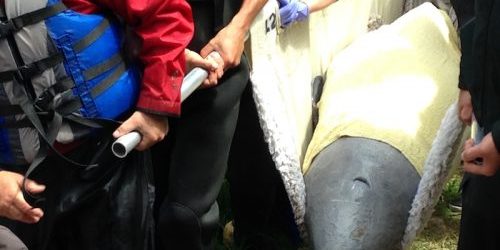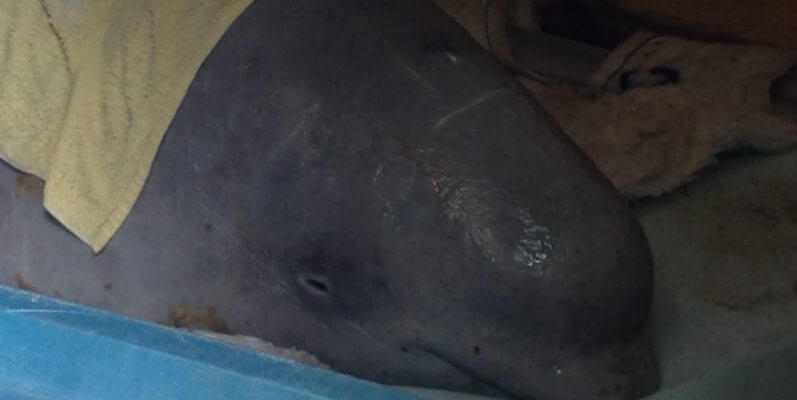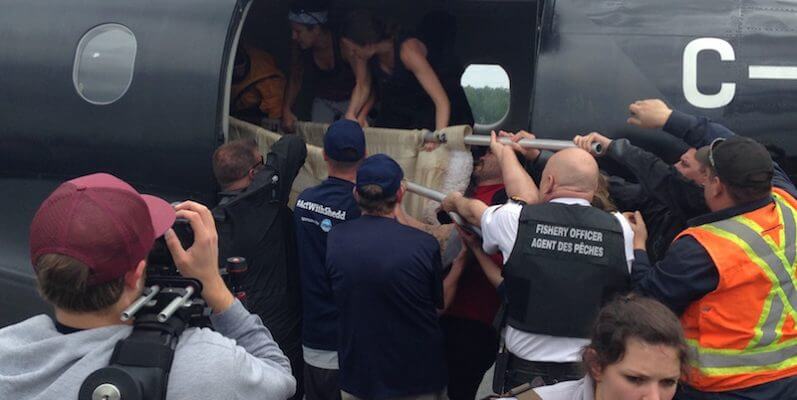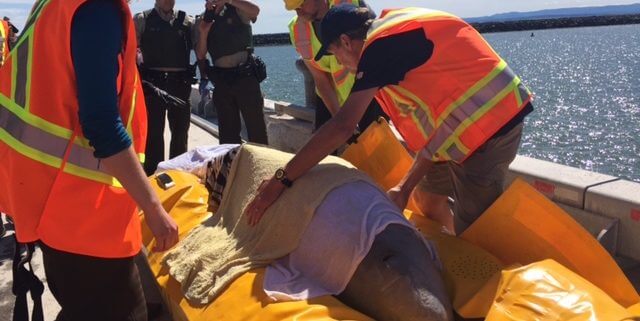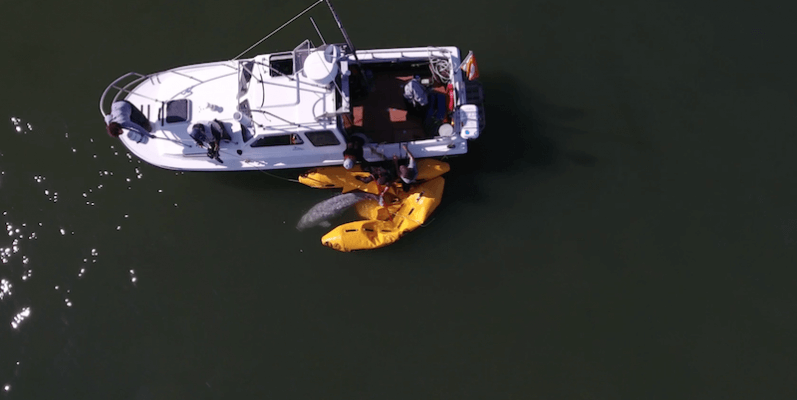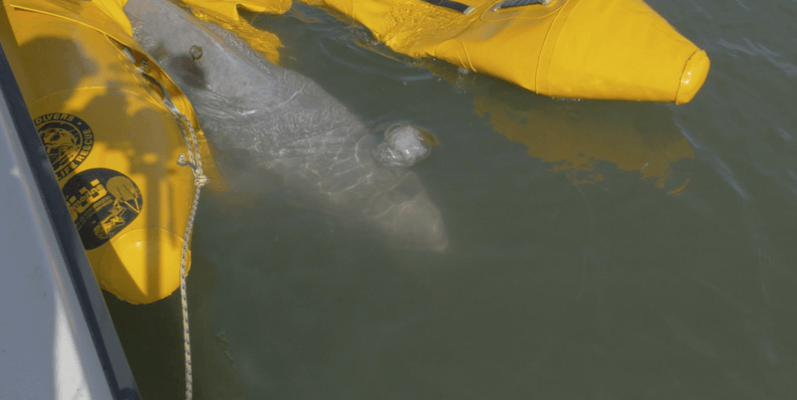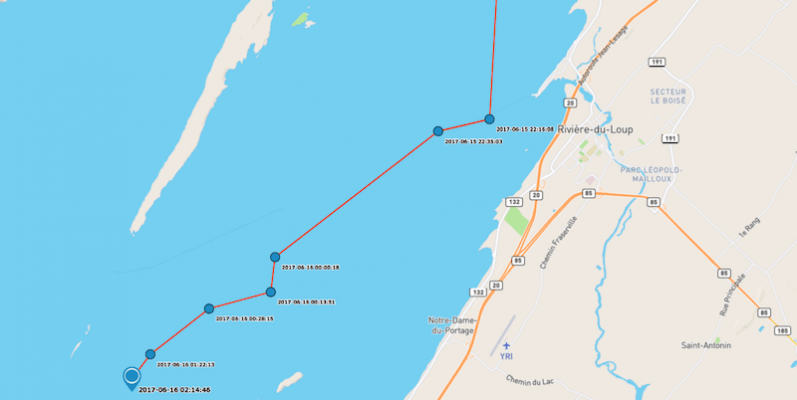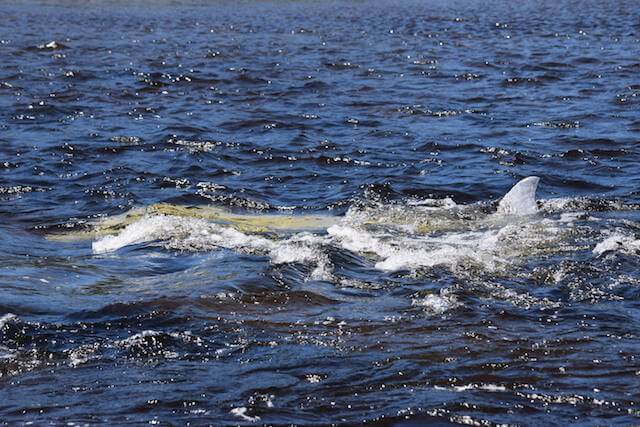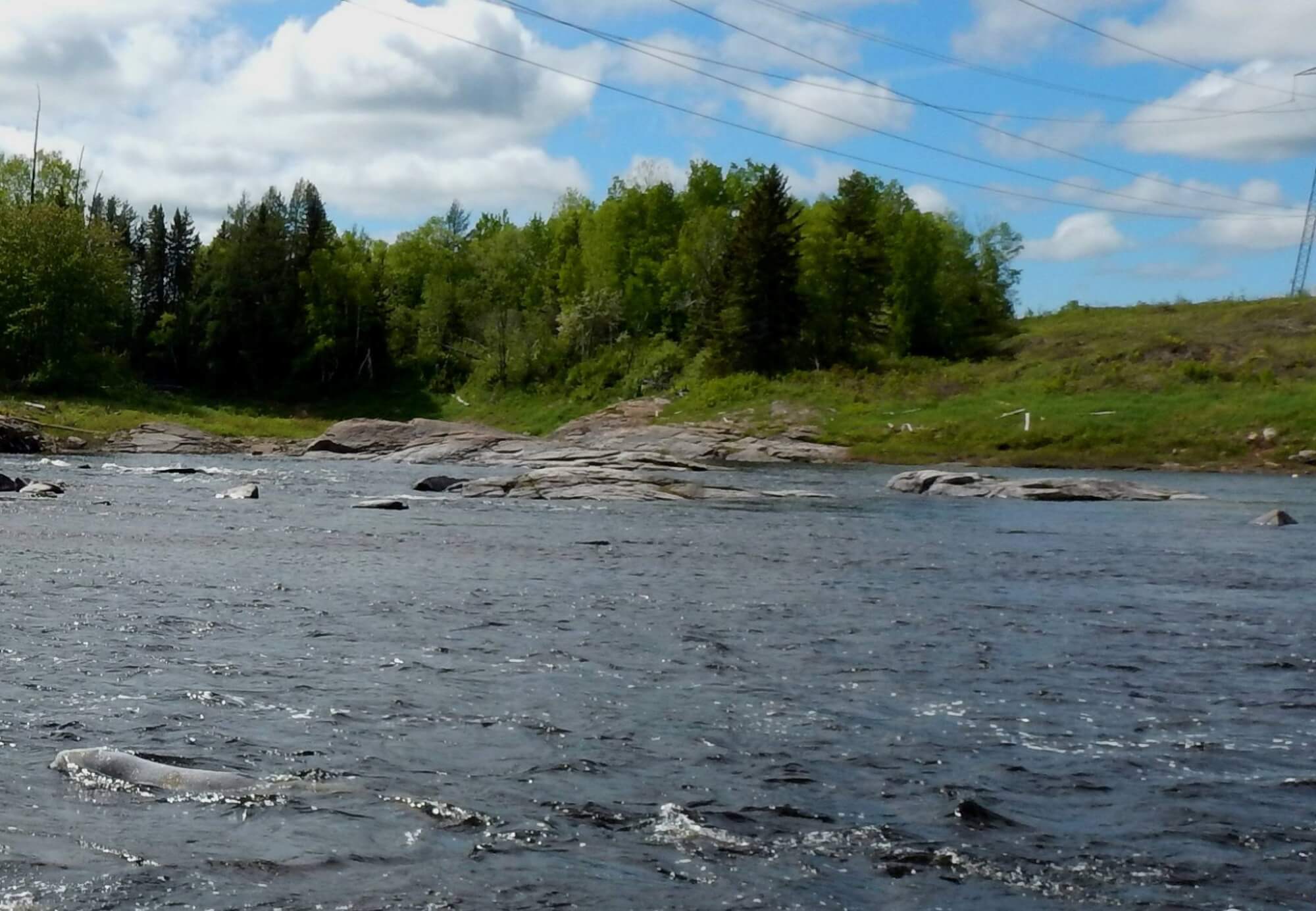Great news! The beluga that was trapped in the Nepisiguit River in New Brunswick and relocated to the St. Lawrence Estuary on June 15, 2017, has been resighted! During this unprecedented operation, the animal was captured and flown to Rivière-du-Loup before being subsequently released into the waters of the St. Lawrence near Cacouna. The St. Lawrence beluga population is endangered. The operation aimed to determine the feasibility and challenges of such a relocation operation, as well as to assess the chances of success for a solitary young beluga to reintegrate a social group over the long term and contribute to the recovery of the population.
“According to the images that have been transmitted to us, the Nepisiguit beluga appears to be in good health. He appears vigorous and is swimming well,” confirms veterinarian specialist Dr. Stéphane Lair of the Université de Montréal’s Faculty of Veterinary Medicine.
The team was surprised, however, that the animal was resighted far from its release site in the summer range of the St. Lawrence beluga. On July 14, the rescued beluga was identified in Ingonish, off Cape Breton, Nova Scotia, by Catherine Kinsman of the Whale Stewardship Project: ” I was called to give atalk in the community about two vagrant belugas. While watching videos of them, I kept looking at the gray beluga’s skin and a scar pattern I was sure I’d seen before. Then photos of the Nepisiguit beluga matched! I was so excited to identify him.”He is in the company of another unidentified male beluga.
Update: The two belugas have left the Ingonish area, in Nova Scotia, and have not been sighted since July 24.
“We suspected that the animal survived the operation and we can now confirm this. This raises some questions, however, about whether this animal will ever contribute to the recovery of the St. Lawrence beluga”says Véronique Lesage, Research Scientist and beluga specialist with Fisheries and Oceans Canada.
Authorities and researchers are concerned about the welfare of these isolated belugas given the degree of interaction they have with humans. “We often get vagrant animals such as these in areas outside the St. Lawrence Estuary and they can become a source of fascination for the public,” says Tonya Wimmer, Executive Director of the Marine Animal Response Society (MARS). “It is important that people maintain a safe distance, which the new federal marine mammal regulations dictate must be at least 100 m.” The two belugas off Ingonish are being closely monitored by Fisheries and Oceans Canada fishery officers.
The adventure of the Nepisiguit beluga is therefore not over. “We had to wait a long time to hear from the Nepisiguit beluga and we would have preferred that he stay with other belugas in the St. Lawrence Estuary. We will try to gather more information on this vagrant individual to understand why the animal has moved away from the St. Lawrence Estuary, and whether or not it will eventually return to this location,” says Robert Michaud, Scientific Director of the Group for Research and Education on Marine Mammals (GREMM) and coordinator of the relocation operation.
The public is reminded that it is illegal to approach within 100 m of these animals and to attempt to feed them or swim or otherwise interact with them. “The best chance for these animals to return to their fellow belugas is if we minimize our interactions with them,” adds Michaud.
Recap of 2017 Events
On June 2, 2017, the Marine Animal Response Society (MARS) received a report of a beluga swimming up the Nepisiguit River near Bathurst, New Brunswick. The whale was not inclined to leave the river and its health was failing. Since the St. Lawrence beluga population is classified as “endangered” and has been declining considerably since the early 2000s, the survival of a single individual could have an influence on the population’s recovery. Based on consultations between MARS, GREMM, Fisheries and Oceans Canada, and veterinarians from the Université de Montréal, the Vancouver Aquarium and the John G. Shedd Aquarium in Chicago, it was decided that the animal should be captured and relocated back to the St. Lawrence Estuary to determine whether it is possible to reintegrate a vagrant beluga with its natal population.
On June 15, the beluga was captured in the river and transported to the Bathurst airport, from where it was flown to Rivière-du-Loup (during which time it was rehydrated) and taken to the port of Gros-Cacouna, where it was placed on a small vessel and released into the water near a group of belugas in the St. Lawrence Estuary. A tag attached to the animal’s back transmitted satellite positions for 19 days following its release. The last time a signal was received from the Nepisiguit River beluga was on July 4.
Since July 4: we lost track
On July 4 in the evening, the GREMM research team did not receive the transmissions of the satellite tag placed on the right flank of the beluga. Hoping for a temporary problem, the researchers waited two more days before having to resolve the following: we lost contact with the beluga.
Some hypotheses may explain the situation: the beacon may be broken; It may have detached itself from the back of the beluga; or the beluga is dead and the body sank or the beluga floats on its back and the beacon finds itself submerged at all times, preventing it from transmitting its signal.
The first hypothesis seems unlikely for researchers. The second one could be more plausible: in 2015, the research project “Belugas on the Move”, which aimed to better understand the winter use of the territory by the belugas, had not produced the expected results. This project also used a LIMPET (Low Impact Minimally Percutaneous Electronic Transmitter) satellite tag and the tag retention did not exceed 13 days. For the placement of the tag on the Nepisiguit beluga, the team therefore attempted a different technique. This technique is used in Alaska on the beluga population of Cook Inlet, and provides a follow-up for 60 to 130 days. In the case of the Nepisiguit beluga, follow-up will have lasted 19 days.
Finally, the hypothesis of the death of the animal could be confirmed if the carcass of the beluga were to run aground on the banks. It would then be possible for the transmission to resume indicating the position of the carcass or the carcass be identified and reported to the Marine Mammal Emergency Call Centre at 1-877-7baleine.
At the time of the release in the water on June 15, the veterinarians had issued a reserved prognosis. They were particularly concerned about the debility of the electrolytes in its blood formula and doubted whether it would be possible to recover. However, the beluga had so far thwarted the prognosis by continuing its course, swimming more than 570 km through the estuary.
“Nothing is being played yet,” says Robert Michaud, Scientific Director of the Group for Research and Education on Marine Mammals and coordinator of the attempt to rescue the young beluga. “If the animal is still alive but its beacon has fallen, it will have left a scar under its dorsal crest which should allow us to recognize it easily. Our season with the belugas begins and we will keep our eyes wide open. ”
The story of the beluga does not stop with the end of the tag. Many developments can still occur, and the rescue operation has already tested hypotheses and advanced science.
Recap
June 2: the Marine Animal Response Society received notification of a beluga roaming the Nepisiguit River, near Bathurst, in New Brunswick.
June 7: The beluga is unable to get out of the river on its own. The displacement plan is prepared.
June 8: Fisheries and Oceans Canada and Marine Animal Response Society experts arrive on the scene to assess the various displacement options.
June 9: Unveiling of the beluga’s relocation plan to the Saint Lawrence. Six days are needed to get the equipment, human resources, optimal weather conditions and all the components required for the response.
June 15: Day of the response.
July 3: The beluga was around Longue-Rive.
July 4 : No new position from the tag was received.
July 4, 2017: a visit to the marine park
The beluga continues what looks like an exploration of the estuary. Since June 30, the beluga has gone upstream the St. Lawrence River to the Saguenay-St. Lawrence Marine Park for a two-days visit. During the night of July 2 to 3, the beluga was in front of Cape Bon-Désir, in the marine park. Tonight, the positions placed him further downstream, near Longue-Rive, Côte-Nord.
June 30: At the end of the summer range
June 27: Back on the south shore
June 23: Closer to the north shore
The Nepisiguit beluga made his first visit to the north coast. Yesterday (June 22) the young beluga of Nepisiguit undertook his first “crossing” of the estuary. After spending a few days off Saint-Fabien, he was last night a few kilometres off the Petits Escoumins. Again the transmission period was relatively short (20:19 to 23:09) but the distance travelled during the last day is quite large. These indications are very slight in judging the condition of the animal, which has not yet been examined. Released on June 15, the beluga of Nepisiguit has nonetheless been freely moving in the St. Lawrence estuary for a week. This in itself is an encouraging sign for researchers who are eagerly waiting to meet him.
June 22: The young beluga continues its exploration
The young beluga of Nepisiguit continues its “exploration” of the estuary. The signals received from the satellite tag last night (June 21) place the beluga still off Saint-Fabien. After a short offshore getaway the day before (June 20th), the beluga moved closer to Bicquette Island and then back to Saint-Fabien. The signal reception period (20:12 to 23:31) remains relatively short, suggesting that our beluga still spends a lot of time on the surface. The wind is still blowing from the south-west, again pushing our patrols to sea.
June 21: Still not a good forecast, but good satellite positions
The young beluga of Nepisiguit returned to the St. Lawrence in Cacouna last June 15 was last night (June 20) still in front of Saint-Fabien. However, he had “taken off”, which is encouraging news, because he had changed his trajectory from the last days leading downstream to the limit of the summer range of the belugas. On the last day, the beluga moved away from the coast to the centre of the estuary.
The signals transmitted by the satellite beacon fixed to the back of the beluga make it possible to reconstitute the trajectory of the beluga. The continuing trajectory towards the gulf of the last few days had raised concerns among researchers. They wondered whether the beluga was able to swim against the current or to stand on the spot or whether he would continue its trajectory and leave the area frequented in summer by the beluga whales.
It has been only 6 days since the Nepisiguit beluga has returned to its natural habitat. The researchers reassess that the situation of the beluga remains critical and that it may take several weeks to re-establish its strength and re-enter a “normal” beluga life. The movements registered yesterday were, however, received as an encouraging sign as he is still in an area heavily frequented by belugas and he seems to be able to swim actively in the current.
Again, the forecast did not allow the researchers to patrol at sea. A story to follow.
June 20: The beluga is close to Saint-Fabien
June 19: Little information, but sill hope
June 18: Here is an update on the young beluga of Nepisiguit
The young beluga of Nepisiguit, who had been released off Cacouna for a little more than two days, was yesterday evening (17 June) swimming close to Ile Blanche, in front of Cacouna. Again, the transmission period was relatively short, from 20:43 to 23:13. This suggests to researchers that the beluga still spends a lot of time on the surface.
However, the distance traveled, more than 10 nautical miles, and the area in which it is located, is encouraging. This area, located within the boundaries of the Saguenay-St.Lawrence Marine Park, is heavily frequented by juvenile belugas. Once the condition of the young beluga improves, one of its challenges will be to bond to a social group. Belugas are not only gregarious, they are social animals. At its age, it is estimated by its length (2.40 m) that it is between 2 and 3 years old, the Nepisiguit beluga should be in a group of females accompanied by young and spend more and more time with juveniles.
We hope to be able to resume the patrols at sea tomorrow if the weather permits.
June 17: Here is an update on young beluga returning from the Nepisiguit river
After a long day of waiting, we received yesterday night (June 16) signals from the satellite tag of the young beluga of the Nepisiguit River (Bathurst NB) brought back to the St. Lawrence estuary and released off Cacouna Thursday on June 15th. Good news, the beluga continue to swim upstream. At the last position received at 9:48 pm, he was in an area regularly frequented by beluga whales. However, we do not know if he joined a group of belugas yet. Patrols at sea by the Group for Research and Education on Marine Mammal Research and Education Group (GREMM) on the Bleuvet will be conducted over the next days to attempt visual contact with the beluga whale.
The current pattern of signal reception could make the task difficult. As was the case on the first day following the release, we obtained locations only for a few hours yesterday, actually between 20:00 and 21:48. The tag attached to the beluga has been programmed to send 250 signals per day and it sends these signals every time it is exposed to the surface. It is possible that the beluga, recovering from its adventure, spends a lot of time at rest, near the surface. The tag then could transmit all its signals within a few hours. Its transmission cycle begins at midnight universal time ie 8:00 pm in Quebec. If our hypothesis is good and the beluga is fine we should have news of our beluga only late in the evening.
The team is very encouraged by these early news. However, we remain cautious about the long-term prognosis. A story to follow.
June 15: Beluga in the Nepisiguit River is now swimming in the St. Lawrencev
After a long day of work to relocate the beluga lost in the Nepisiguit River to the St. Lawrence Estuary, the response team announced that he is swimming freely in his original range. All steps of the operation have been completed on June 15. The teams are returning to their home ports, relieved to see the animal swimming and breathing in the river, but aware that the beluga’s survival is not completely guaranteed. The whale is and will continue to be monitored.
At daybreak, teams prepared themselves at each response site: the Nepisiguit River, the Bathurst Airport, the Rivière-du-Loup Airport, and the Port of Gros-Cacouna.
A team from Fisheries and Oceans Canada and the Marine Animal Response Society caught the young male around 12 p.m., Atlantic time. This was not an easy feat. Once the whale was caught, veterinarians from the Université de Montréal Faculty of Veterinary Medicine, the Vancouver Aquarium and the Shedd Aquarium tested his condition before he was transported. The veterinarians gave him a fair prognosis. He had drank a lot of fresh water and lost weight. He needed to be relocated for his survival in the very short term.
During transport by truck and plane, the beluga’s condition remained stable. The beluga arrived in Rivière-du-Loup at about 1:30 p.m. Quebec time. He was immediately transported to the port of Gros-Cacouna. After a satellite transmitter was inserted, blood was taken, and a biopsy was done, the animal was lowered by crane onto a submerged pontoon attached to the Bleuvet, the Group for Research and Education on Marine Mammals’ research vessel. When the animal hit the salt water, it began to breathe more easily, more calmly and at a more relaxed rate.
A Parks Canada team patrolled the sea during the day in search of beluga pods. The Bleuvetjoined the Parks Canada vessel Alliance with a pod made up of young and female belugas two nautical miles from the port At 4:54 p.m., the beluga was released into the St. Lawrence Estuary. During the first breathing sequence, it swam slowly. The second breathing sequence was energetic; the whale was with some small grey belugas (juveniles). The team could hear the beluga’s calls through a hydrophone. It then lost visual contact with the animal, but its whereabouts were located with the aid of the satellite transmitter. Over the next few hours and days, the beluga will be track remotely. It is hoped that it will be integrated into a group of other belugas. The team returned to port encouraged, but aware that there were still a number of challenges facing the beluga.
Here is a drone footage of the release in the St. Lawrence. At first, the beluga swam quite slowly but get more vigorous after its first breath. You can see the tag on its right lap.
Summary of Events
- June 2: the Marine Animal Response Society received notification of a beluga roaming the Nepisiguit River, near Bathurst, in New Brunswick.
- June 7: The beluga is unable to get out of the river on its own. The displacement plan is prepared.
- June 8: Fisheries and Oceans Canada and Marine Animal Response Society experts arrive on the scene to assess the various displacement options.
- June 9: Unveiling of the beluga’s relocation plan to the Saint Lawrence. Six days are needed to get the equipment, human resources, optimal weather conditions and all the components required for the response.
- June 15: Day of the response.
- June 16: No new position from the tag was received at 3pm. We hope to get one by the end of the day.
We sincerely thank all those who participated in the response:
Group for Research and Education on Marine Mammals, Marine Animal Response Society, Maritime Marine Animal Response Network, Réseau québécois d’urgences pour les mammifères marins [Quebec Marine Mammals Emergency Response Network], Fisheries and Oceans Canada’s Science Team, Conservation and Protection Team, and the Fisheries and Oceans Canada, Gulf Region/Fisheries and Oceans Canada, Quebec Region Management Team, Parks Canada, Transport Canada, Centre de remorquage 2000, the Université de Montréal Faculté de médecine vétérinaire, Vancouver Aquarium, Shedd Aquarium, Whale Stewardship Project, the Port of Gros-Cacouna, Arrimage Québec, the Rivière-du-Loup Airport, Bathurst Regional Airport, the Bathurst and Rivière-du-Loup police services and all on-site volunteers at different locations.
Follow the operation with #greatbelugarescue on Twitter.
June 13: The Whale Stewardship Project team observed the behaviour of the beluga
Over the past two days, Cathy Kinsman and Ken Petersen from the Whale Stewardship Project have been observing the behaviour of the lone beluga. Since 1998, the Whale Stewardship Project has been conducting research projects on solitary and social belugas that stray outside their normal range. The Nepisiguit River beluga probably measures less than 2.5 m and is between 2 and 3 years old.
Cathy Kinsman explain that the beluga’s behaviour is particularly repetitive: “It’s always in the rapids. It has been moving around in a radius of 2 or 3 m at the most. It continues to swim and its breathing has been calm and regular. For the last two days, that is pretty much all it has been doing. It doesn’t appear to be struggling.”
The beluga has been adopting the same three postures during its stationary swim. The first is a surface swim, where the dorsal crest stays close to the waves. On occasion, the beluga sticks one eye out of the water, without necessarily assuming a typical “spyhopping” position. The second posture has the beluga on its side, with its back quite close to a rocky ledge. From the observers’ perspective, it is impossible to say whether the beluga’s skin touches the rock, but it does seem to come close to rubbing against it. At this point, the tail may sometimes partially emerge. Finally, the third type of swim brings the beluga’s belly toward the surface. This last behaviour was also observed in the drone sequence filmed on June 8.
Previously, the beluga rescued from the St. Paul River also had a period of repetitive stationary movement. Écho, a.k.a. Casper, held itself vertically without moving for long periods.
At the present moment, the beluga’s skin seems to be in better condition than it was at the time of initial observations. “It still has some diatom patches, but they are much smaller. Nothing to be concerned about. Its skin does appear to be better, clearer, and more normal.”
The beluga does not seem to vocalize, either: “We have not had any confirmation of vocalization. Since the beluga has been staying in the rapids, we haven’t had the chance to use the hydrophone.”
Cathy Kinsman hopes the operation will be carried out over the next few days as planned: “The one thing that really concerns me is that it doesn’t appear to be foraging. We have had no sights of fish jumping out of the water close to the animal, no sign of its mouth open, no behaviour or indication of feeding at all in the past two days. It stays parallel to the surface and hasn’t been diving. Its psychological state is a concern. If the animal is really not feeding, it is really important that the plan go forward.”
Regarding the water level, it is still acceptable, but has been gradually dropping. Water temperatures also seem to be adequate, but are expected to rise gradually. “The clock is ticking. It’s not an emergency yet, but the beluga needs to be moved soon.”
June 13: Beluga’s Status Re-assessed
The beluga was re-evaluated today. It stills appears to be in robust health, spending most of its time swimming in the current. GREMM Scientific Director Robert Michaud was on site with Yves Morin of Fisheries and Oceans Canada, a specialist in beluga capture in Hudson Bay, as well as Tim Binder, beluga expert at the Shedd Aquarium, and Catherine Kinsman of the Whale Stewardship Project, an organization specializing in lone and out-of-range belugas.
In light of the information obtained today, the plan to relocate the beluga to the St. Lawrence Estuary sometime this week is being maintained, once all the equipment has been gathered and all the conditions are met. Over the next few days, Marine Mammal Emergencies volunteers will oversee public awareness. DFO officers will continue to visit the site on a regular basis, while Catherine Kinsman will make detailed observations of the beluga’s behaviour.
June 12 : Relocation Planned
An attempt will be made to relocate the stray beluga in New Brunswick’s Nepisiguit River to the St. Lawrence Estuary. This decision is unprecedented for St. Lawrence belugas. Experience suggests that the operation will be a risky one, but it could open up new prospects in conservation and rescue. This tricky intervention brings together experts from the Marine Animal Response Society (MARS), the Department of Fisheries and Oceans Canada (DFO), the Quebec Marine Mammal Emergency Network, the Group for Research and Education on Marine Mammals (GREMM), Chicago’s Shedd Aquarium and the Vancouver Aquarium.
A beluga that could help save others
After analyzing a number of different options, the expert team concluded that the animal trapped in the river must be moved. They decided to attempt to release it back into the St. Lawrence, its presumed place of origin.
“Even if each step of the operation brings its own set of risks, the experts collaborating in the effort all believe that the end justifies the means. As the state of the St. Lawrence beluga population is precarious, the rescue and reintroduction of a single individual could have an impact on the long-term survival of the species,” believes GREMM Scientific Director Robert Michaud.
In order to track its movements and gauge the success of the operation, a satellite tag will be placed on the animal. Ultimately, if each step unfolds as planned, experts may elect to reintroduce other animals back into their natural environment in cases involving endangered marine mammals outside their normal range or in a vulnerable situation.
Three-step Plan
Sometime within the next week, once all the necessary equipment has been gathered, the operation – which will have to be carried out with maximum efficiency (in less than one day) – will get underway.
First, the MARS and DFO teams will capture the animal. The beluga will be brought to the mouth of the river, where its condition will be re-evaluated.
Subsequently, under the supervision of veterinarian Stéphane Lair, a team from the Shedd Aquarium will transport the beluga to the St. Lawrence Estuary in a refrigerated truck. The Shedd Aquarium has expertise in safely transporting marine mammals over land.
Lastly, the GREMM team will orchestrate the animal’s release into waters that are highly frequented by belugas. Team members are hopeful that the Bathurst beluga will soon be able to once again socialize with members of its own kind, which is a key element of the rescue plan. Indeed, other incidents involving vagrant belugas have often had tragic endings. Being highly social creatures, belugas tend to interact with humans and watercraft when isolated from their group. Consequently, the risks are greater and accidents, unfortunately, occur frequently.
Learning from the past
In 2001, three beluga whales were trapped in a river in the Lower North Shore region. Despite the fact that they were in a salmon pool, two of the three belugas died of starvation before any human response could be organized. Subsequently, the third beluga was moved to the bay at the mouth of the river. It was later observed in a Newfoundland village, where it was increasingly interacting with fishermen and ships. A few days later, the animal ended up dying following a collision with a watercraft.
With the Nepisiguit River beluga, the experts involved are hoping to successfully reintroduce the animal into a population of belugas in order to ensure the long-term survival of the individual. Even if each step comes with risks, inaction will spell imminent death for the animal.
June 8: A vagrant beluga in Bathurst, New Brunswick
After observations at the field and a review of the images taken by drone of the animal, the experts continue to analyze the situation. For now, the beluga appears to be in good health, but prolonged stay in freshwater and shallow water can be dangerous. Different options are evaluated to move the animal. You can see here extracts from the video filmed by drone yesterday morning of the beluga.
June 6: A Vagrant Beluga in New Brunswick
A lone beluga whale in the Nepisiguit River near Bathurst, New Brunswick was reported to the Marine Animal Response Society (MARS), organization responsible for responding to stranded or vulnerable marine mammals in the Maritime Provinces. The Nepisiguit River, which empties into Chaleur Bay, is currently too low for the beluga to reach the open sea on its own.
A team made up of MARS, the Quebec Marine Mammal Emergency Response Network, the Group for Research and Education on Marine Mammals, the Whale Stewardship Project and the Maurice Lamontagne Institute (Fisheries and Oceans Canada) is evaluating response options. Before any action is taken, researchers must ensure that the animal is in good health.
Since the beluga is a species protected by the Species at Risk Act, it is prohibited to disturb, harass or interact with it in any manner whatsoever. The public is encouraged to keep their distance from the animal.
At the present time, it is not known whether the beluga belongs to the St. Lawrence population or the Arctic population.
Unusual, but not exceptional
This is not the first time that a solitary beluga has been seen outside its usual range. In 2015, no fewer than four cases were reported in Nova Scotia, New Brunswick, the US East Coast and even England. You can read about them in the Whales Online archives. Other unexpected observations also occur from time to time. Last summer, a narwhal was seen with belugas in the St. Lawrence.




